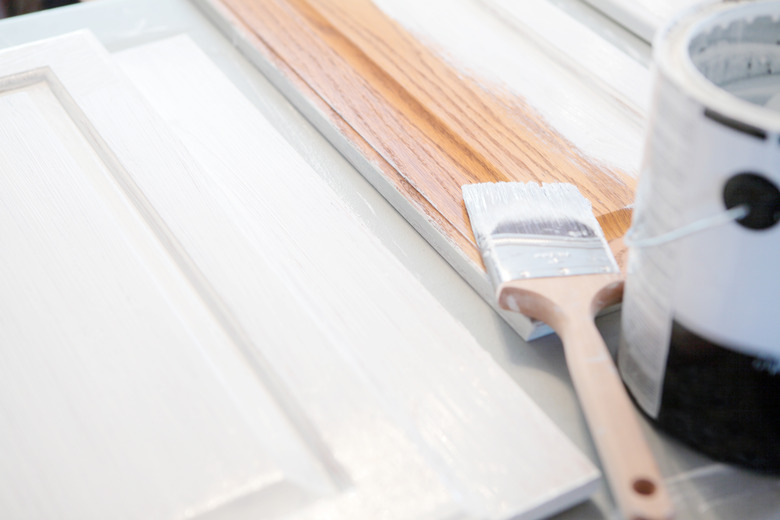Why Do People Put Paintbrushes In The Fridge?
We may receive a commission on purchases made from links.
If you visit someone's house and see a paintbrush in their refrigerator or freezer, they're not absentminded — they're probably just in the middle of a paint job. As it turns out, wrapping up your brushes or paint rollers in aluminum foil, plastic wrap, or a plastic bag before chilling them is an excellent storage method. Why exactly? Because cutting off airflow makes the paint harden more slowly, making it useful much longer than if you were to simply leave the paintbrush out in the open.
In fact, properly wrapped and stored painting tools, including brushes, paint rollers, and paint pads, can easily be kept ready for use more than a week later. Some DIYers even find that their brushes are still ready for use months after they were put in the refrigerator.
So, how exactly do you chill a paintbrush? And should you put it in the freezer or the refrigerator? Here's what to know.
Should You Store Paintbrushes in a Freezer or Fridge?
Should You Store Paintbrushes in a Freezer or Fridge?
Freezer
- Best for paintbrushes used with oil-based paint.
- This cuts down on the cleaning process, since oil-based paint has to be cleaned with solvents.
Refrigerator
- Best for paintbrushes used with water-based paint.
- Putting brushes in the freezer with water-based paint will cause the paint to be stringy and clumpy.
Chilling a paintbrush is a great way to ensure that it doesn't harden and dry out in the middle of your painting project, but should you be sticking it in the freezer or the refrigerator?
While some people freeze their paintbrushes, this is typically unnecessary and can actually damage many types of paintbrushes, causing them to become stringy and lumpy. In fact, if you're taking a short break for a few hours or even overnight, just wrapping up your paintbrush or roller and leaving it at room temperature should usually provide enough protection to prevent it from drying out. However, if you need to keep your painting tools ready to go for a day or two, it's best to pop them in the fridge to extend the workable life span of the paint.
Many people who discover this trick may assume a paintbrush should last even longer when frozen. But if you're working with water-based paint, which includes all forms of latex paint, acrylic paint, and chalk paint, it's best to avoid putting these products in the freezer. That's because freezing paint damages its emulsification, meaning the ingredients will begin to separate, which can cause the paint to become stringy or clumpy. Trying to use paint that has separated will leave your paint job looking sloppy and lumpy.
On the other hand, brushes used with oil paint can be placed in your freezer because this paint is made from alkyd resins, solvents, metal naphthenates, and pigments, which technically can freeze but only at temperatures dramatically lower than the 0 degrees Fahrenheit that most home freezers are set at. Freezing your painting tools is particularly beneficial if you are using oil paint since cleaning these brushes and rollers requires a solvent, such as mineral oil or paint thinner, whereas if you want to clean out a brush or roller covered in water-based paint, you only need water and a little dish soap.
Tip
No matter what type of paint you're using, if you store your painting supplies in the freezer or refrigerator, remember to take them out (leave them wrapped) and allow them to warm up for a few hours so the paint can warm up to over 50 degrees Fahrenheit.
At temperatures below this point, both water-based and oil-based paints are too thick to paint with, which can result in poor coverage, bubbling, poor color consistency, and other issues. With rollers, a defrosting process is particularly important, as it also allows the nap to become fully pliable again.
How to Properly Wrap Paintbrushes
How to Properly Wrap Paintbrushes
One of the most important factors in making this trick work is how well you wrap your paintbrushes, rollers, or paint pads. No matter what kind of paint you're using, it's important to protect the wet paint from exposure to air as much as possible since that's what dries the paint. Sealing your tools can be done with a plastic bag, plastic wrap, or aluminum foil, but aluminum foil is the most effective. Here's how to secure your tools effectively:
- Wrap your supplies in a 12-inch-long
piece of heavy-duty aluminum foil, which creates an airtight seal and can
perfectly conform to the shape of any brush or roller. - If you're worried that the
foil may get ripped in the fridge, double-wrap the tools for extra
protection.
If you only need to keep the paint fresh until the next day or two, you'll probably be safe popping your brushes or rollers into gallon-size Ziploc bags or resealable sandwich bags and squeezing out as much air as possible before sealing. When using a roller, it's best to remove the paint roller cover from the handle before storing so it will fit securely in a bag. You can leave it on or off the roller if wrapping it in aluminum foil, but it's typically easier to fit in the fridge without the handle. Should your paintbrush be too big for a bag, cut a small hole in one side to accommodate the handle and then use masking tape to cut off airflow through the hole — or better yet, just stick with aluminum foil.
Prepping for Storage
Prepping for Storage
Although it might go against your better instincts, it's best to not clean your paintbrushes too much before storing them in the refrigerator. Thin layers of paint dry faster than thick layers, so it's best to leave a thick layer of paint on brushes, rollers, or pads before storing them in your refrigerator in order to maximize the amount of time they can be stored before the paint starts to harden.
You don't need to leave your painting tools dripping wet; just leave on what you would use when you're about to apply some paint in order to ensure the surface is wet when you apply your wrappings.

